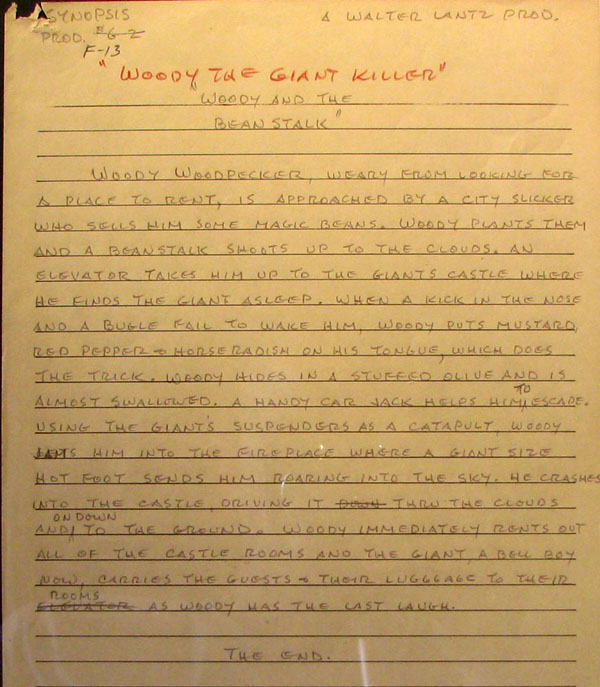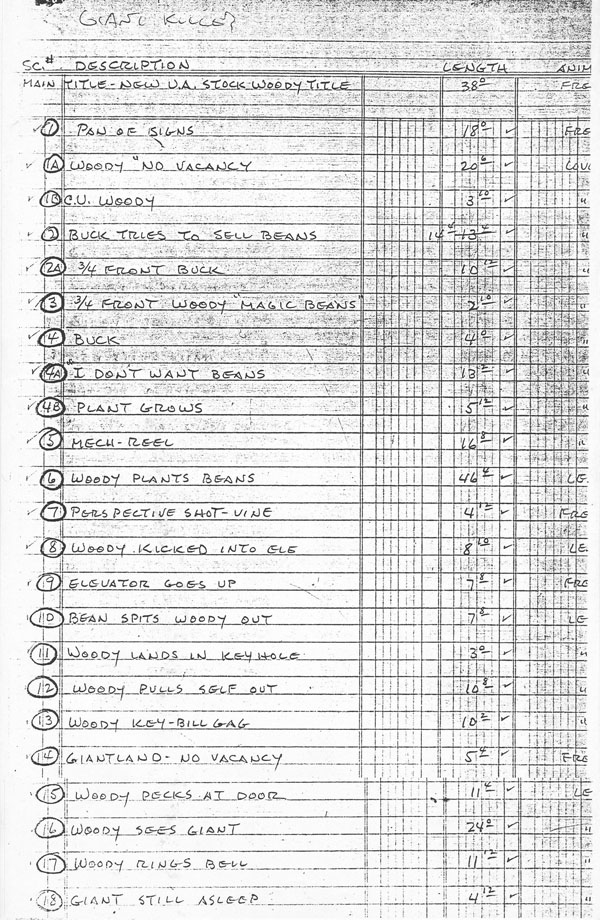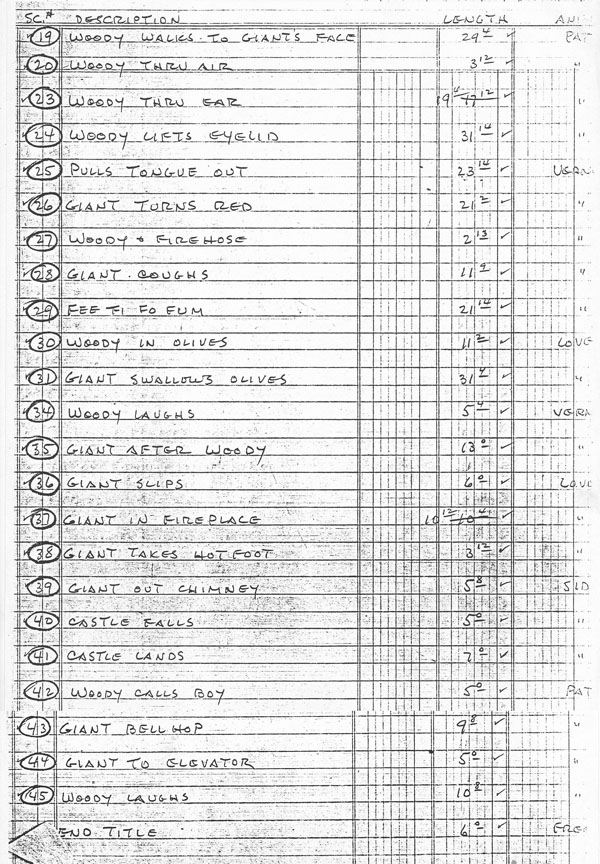
The surviving original art for the title card
Today, we look at one of Dick Lundy’s best Woody Woodpecker cartoons!
The immortal tale Jack and the Beanstalk, like other familiar fables and fairy tales, has always been rife for a straightforward retelling or parody on-screen. Many animation studios used this handy material — Disney, Warner Bros., Fleischer, Famous Studios, Ub Iwerks, Van Beuren and Terrytoons. Walter Lantz previously used the story in a 1924 Dinky Doodle, The Giant Killer, in which the beanstalk grows from a flowerpot after co-star Weakheart buries an anthropomorphic bean into the soil.
 Woody the Giant Killer’s version is just as arbitrary; city slicker Buck Beaver overhears the discouraged woodpecker’s woes of finding a place to rent and offers him the magic beans. Throughout the cartoon, Woody isn’t curious about the immense surroundings of the giant’s castle; instead, he attempts to wake up the giant to further his pursuit of much-needed lodgings. By the end, Woody has the last laugh (wonderfully animated by Pat Matthews) as the giant caters to him as his bellhop at his newly established Castle Apartments.
Woody the Giant Killer’s version is just as arbitrary; city slicker Buck Beaver overhears the discouraged woodpecker’s woes of finding a place to rent and offers him the magic beans. Throughout the cartoon, Woody isn’t curious about the immense surroundings of the giant’s castle; instead, he attempts to wake up the giant to further his pursuit of much-needed lodgings. By the end, Woody has the last laugh (wonderfully animated by Pat Matthews) as the giant caters to him as his bellhop at his newly established Castle Apartments.
The draft indicates the main titles were intended for United Artists’ release but this cartoon was the last Lantz cartoon released by Universal until his studio re-opened in 1950. Under Dick Lundy’s direction, the quality of animation flourished. Much like some of the MGM drafts shared on this page, this cartoon’s draft showed that Lundy dispensed large amounts of footage to each animator. In contrast, the Shamus Culhane documents demonstrate how he assigned intermittent blocks of scenes as a director.
Ed Love handles the entire opening sequence with Woody and Buck Beaver (voiced by Harry E. Lang), who would make another appearance in Scrappy Birthday. Scene 2, of Buck bringing Woody “a little closer” only to recoil at the woodpecker’s breath, is a great comic touch. Love also animates the later action inside of the castle, including Woody prying the giant’s jaws with a car jack and ejecting teeth (and gums) from his mouth. Les Kline’s animation improved in Lundy’s cartoons, shown in the brilliant posing of scene 6, when Woody utters the magic words to make the beanstalk grow, to no avail. Kline’s timing becomes sharper in later sequences, such as in scene 17’s dialogue, when Woody rings the bell, demanding service for a room.
Verne Harding’s scenes in Giant Killer are reminiscent of former Disney animator/freelancer Fred Moore’s animation. She recalled absorbing guidance from Moore at the studio in later years: “He taught me something about getting action in a solid head. You do a character making a take: his head is solid. You stretch it and just get the effect; you don’t leave it there. Change the shape but still keep it cute. Don’t go into any awful-looking thing.”
Scene 26, which shows the giant’s reaction to spicy condiments, serves as an example. It shows the burning sensation on his taste buds without highly embellishing the action. However, in looking at the scene carefully, the scene is also astoundingly parallel to Emery Hawkins’ animation. It’s fascinating to wonder if she took advice from Hawkins as well, but it can only be speculated.

The original hand-written premise for “Wood The Giant Killer”
Pat Matthews – first named John R. Matthews – does some of his finest animation in this cartoon. His broad design sense became highly strengthened in Lundy’s cartoons. Matthews adds a brilliant piece of manic action (in scenes 24 and 45) in Giant Killer, when Woody’s neck ring expands as he does a take, a trademark he used in many entries. According to his son, Matthews started out as a Disney in-betweener in 1938, but lost his job when these artists went on strike. After his stint at Lantz ended with the studio’s closure in the late ‘40s, he animated for UPA on their most acclaimed cartoons, including a solo job on Ted Parmalee’s The Tell-Tale Heart. In 1950, Matthews underwent brain surgery. A metal plate was inserted into his head due to his injuries in World War II. He tried to become a director at the studio, but the operation lowered his productivity. None of the key directors wanted to work with Matthews due to his slowness.
He left UPA and moved to Mexico City in 1953, where he directed commercials for a company run by Richard Tompkins. Later in the 1950s, he returned to the West to direct more commercials for Playhouse Pictures. Around 1959, he struggled to find other animation work overseas and finally became a television director in Australia. Matthews’ health deteriorated. He gradually lost functionality on the left side of his body, though he could still draw. In the mid-‘60s, he returned to the Tompkins studio. Around 1972, as a Spanish-language Sesame Street was in progress, Matthews was killed in a car accident at age 56.
Enjoy the breakdown video, and say the magic words to start it up: “Abra-cadabra, presto change-o, alley oop!”


(Thanks to Mark Kausler, Joe Adamson, Keith Scott and Kevin Langley for their help.)


 DEVON BAXTER is a film restoration artist, video editor, and animation researcher/writer currently residing in Pennsylvania. He also hosts a
DEVON BAXTER is a film restoration artist, video editor, and animation researcher/writer currently residing in Pennsylvania. He also hosts a 





















































































During his time at Tompkins’ studio, Dibujos Animados SA, Pat Matthews also worked as director on a series of anti-communist propaganda cartoons aimed at Mexican audiences:
https://www.youtube.com/playlist?list=PLA622uOKUCGwzDovB7X9FLiZIQ1VHrFaR
Other UPA animators like Gerald Ray and Tom McDonald were also directors. The shorts were written by Ernesto “Ernie” Terrazas, who would later go on to write for Rocky & Bullwinkle.
Correction: Terrazas was a director on Rocky & Bullwinkle, not a writer.
Kinda said to learn that brain damage was what cost him a director’s job at UPA though. He certainly did a fine job on the few flourishes of animation seen in “The Tell-Tale Heart”.
Just having a chance to watch them right now, those are quite well-done shorts, though I did wondered why they happened to be dubbed in English, were these made for export? I guess I’ll never know (unless I ask the YouTube user). The animation reminded me of early UPA stuff like the Fox & Crow cartoons they did. Felt right at home here, though the heavy-handed message I could do without, though I see why they did it at all. The stories in these films could easily be standalone without the propaganda used.
Aside from Terrazas directing on Rocky & Bullwinkle, I see he ended up as story director for several Hanna-Barbera shows in the 70’s/early 80’s, though he doesn’t have much to go on via imdb.com though nice to see he was on The Three Caballeros as a writer.
Buck Beaver also appeared in the Andy Panda cartoon “Scrappy Birthday.”
Watching this cartoon, I noticed that Lundy’s Woody has a touch of Donald Duck in him. The way he gets angry when the beans don’t grow at first, for instance, is reminiscent of Donald. Seeing as Lundy used to be Donald’s top animator and director, this seems understandable.
Just to add, the notations of “Fred” on the draught are for background artist Fred Brunish.
It’s actually meant to say “free” as in “free footage.” The document pages are cut off.
That would be a nice way to credit Brunish’s dazzling BG work, though.
I’ve loved this cartoon since childhood, and I never tire of watching it again. Devon, you might give credit to Emery Hawkins for the main title animation of Woody, which Walter Lantz used through the United Artists years. Just about every scene in the cartoon is good, I especially like Ed Love’s slip timing on Sc. 36, as the giant slips on banana peels before catapaulting into the fireplace. Ed was a master of this type of delayed timing, I actually feel a physical sensation looking at it.
I never tire of watching it again.
Ditto! My favorite shot is the one of the Woody laugh in the bowl of olives. A pure wacky cartoon character moment.
Buck Beaver started out as a Lantz comic character much earlier, around 1944; but the design suggested a character created for animation from the start. Always wondered if some earlier cartoon appearances were planned and shelved.
I suppose we’ll never know. He did seem like an interesting character to use more often, though I kinda wish he got his comeuppance for his shystie move on both Woody and Andy in the two cartoons mentioned.
Funny cartoon. Always liked how Woody’s head elongates when he shoves the banana in his mouth then shrinks back down when swallowing it.
This cartoon also has a special memory since my childhood, not only from THE WOODY WOODPECKER SHOW, it was one of the cartoons included in Kenners hand cranked Give-A-Show Super 8mm toy projector I received one Christmas.
Edited down to about three minutes looped inside a cartridge, I would watch it over and over mesmerized by the animation. Even cranking frame by frame studying it.
No wonder my heads messed up in Gagland.
http://www.patcartoons.blogspot.com/
Always loved this,esp.,after the giant does his customary “Fee, Fi, Fo, Fum, I smell..” line, Woody Woodpecker’s cut-oiff line “You sure do!”